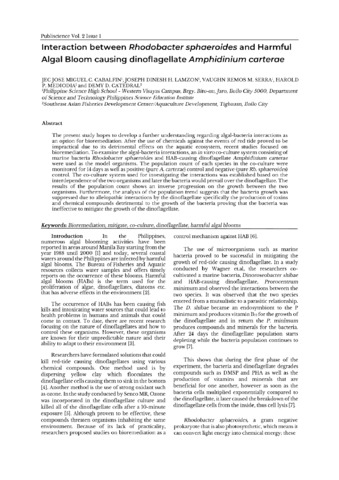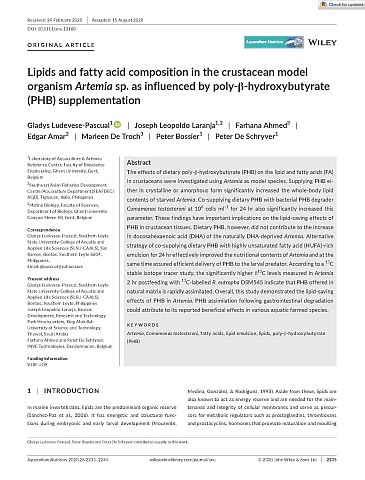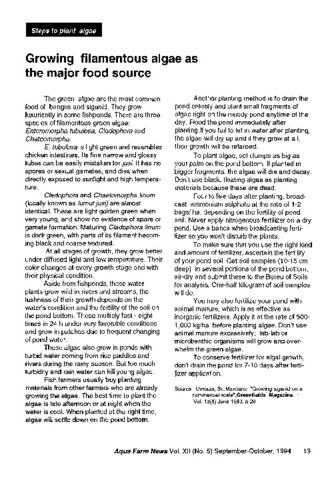Interaction between Rhodobacter sphaeroides and Harmful Algal Bloom (HAB) causing dinoflagellate Amphidinium carterae
Share
Abstract
The present study hopes to develop a further understanding regarding algal-bacteria interactions as an option for bioremediation. After the use of chemicals against the events of the red tide proved to be impractical due to its detrimental effects on the aquatic ecosystem, recent studies focused on bioremediation. To examine the algal – bacteria interactions, an in vitro co-culture system consisting of marine bacteria Rhodobacter sphaeroides and HAB – causing dinoflagellate Amphidinium carterae were used as the model organisms. The population count of each species in the co-culture were monitored for 14 days as well as positive (pure A. carterae) control and negative (pure Rb. sphaeroides) control. The co-culture system used for investigating the interactions was established based on the interdependence of the two organisms and later the bacteria would prevail over the dinoflagellate. The results of the population count shows an inverse progression on the growth between the two organisms. Furthermore, the analysis of the populations trend suggests that the bacteria growth was suppressed due to allelopathic interactions by the dinoflagellate specifically the production of toxins and chemical compounds detrimental to the growth of the bacteria proving that the bacteria was ineffective to mitigate the growth of the dinoflagellate.
Suggested Citation
Cabalfin, J. J. M. C., Lamzon, J. D. H., Serra, V. R. M., Mediodia, H. P., & Catedral, D. D. (2019). Interaction between Rhodobacter sphaeroides and Harmful Algal Bloom (HAB) causing dinoflagellate Amphidinium carterae. Publiscience , 2(1), 159-164. http://hdl.handle.net/10862/5999
Subject
Taxonomic term
Collections
- AQD Journal Articles [1240]
Related items
Showing items related by title, author, creator and subject.
-
Lipids and fatty acid composition in the crustacean model organism Artemia sp. as influenced by poly‐β‐hydroxybutyrate (PHB) supplementation
Ludevese-Pascual, Gladys; Laranja, Joseph Leopoldo; Ahmed, Farhana; Amar, Edgar; De Troch, Marleen; Bossier, Peter; De Schryver, Peter (Wiley, 2020-12)The effects of dietary poly-β-hydroxybutyrate (PHB) on the lipid and fatty acids (FA) in crustaceans were investigated using Artemia as model species. Supplying PHB either in crystalline or amorphous form significantly ... -
Monitoring and identification of harmful algal blooms in Southeast Asia to support SDG 14.1
Soon Eong, Yeap; Sulit, Virgilia T. (Secretariat, Southeast Asian Fisheries Development Center, 2017)One of the targets of SDG 14 on conservation and sustainable use of oceans, seas and marine resources for sustainable development adopted in September 2015, indicates that (SDG 14.1): By 2025, ‘marine pollution of all kinds ... -
Growing filamentous algae as the major food source
Aldon, Eva T.; Southeast Asian Fisheries Development Center, Aquaculture Department (Aquaculture Department, Southeast Asian Fisheries Development Center, 1994)






